Iguacu - Iguazu
Nastepnego dnia udajemy sie ogladac wodospady z bliska po stronie argentynskiej. Tu turystow wozi maly pociag elektryczny, a nie autobus, a park jest znacznie wiekszy. Tu kupujemy tez w rozsadnej cenie przejazdzke lodzia pod kilkoma mniejszymi wodospadami. Kiedy nasz sternik podplywa pod jedna z malych kaskad (sa ich tam dziesiatki) mam ochote krzyczec! Wrazenie jest dosc piorunujace, zwlaszcza kiedy lodz na chwile znajduje sie pod strumieniem wody. Mam wrazenie, ze zaraz zatoniemy. Aparat bezpieczny w gumowej torbie, ja natomiast mimo goreteksowej kurtki jestem oczywiscie caly przemoczony (woda nalala sie rzecz jasna od gory, przez kolnierz hehe). To chyba najlepiej wydane pieniadze od poczatku wycieczki!
Reszte parku zwiedzamy na piechote, co zajmuje nam reszte dnia. Nastepnego dnia chcemy jeszcze tylko zwiedzic ogromna zapore Itaipu na terenie Brazylii i ruszamy w strone boskiego Buenos!
Wstajemy rano i ruszamy do zapory. Na granicy brazylisko-argentynskiej jak zwykle odprawa tylko u Argentynczykow (Brazylia nie wstawia pieczatek, jesli wyjezdzasz na 1 lub 2 dni). Nowa oznaka cywilizacji Argentyny bylo to, ze granice przekracza sie tu jak w Europie (poza strefa Schengen), czyli pieczatka do paszportu i czesc. Brazylijczycy trzymaja sie lokalnych zwyczajow, czyli przy wjezdzie trzeba wypelnic formularz, w ktorym pytaja nawet o zawod, nie mowiac o stanie cywilnym, a nastepnie zdac ten formularz przy wyjezdzie. Jesli go zgubisz, placisz 250 zl kary. Chore, ale stosowane prawie na calym kontynencie. Jak mowilem, mozna opuscic ten kraj nie stemplujac paszportu, ale z kolejnym wjazdem w innym miejscu lub o innym czasie moga byc problemy (np. jest pieczatka wjazdowa a brak wyjazdowej). W Argentynie natomiast trzeba przechodzic przez specjalna wycieraczke nasaczona jakims srodkiem dezynfekujacym. Ciekawe, ale niezbyt klopotliwe.
Asia jest w pochmurnym nastroju, bo dwa dni wczesniej w Brazylii kupila sobie koszulke z napisem “Jestem Brazylijka” a ja gdziej jej te koszulke zapodzialem. Kiedy na miejscu w sklepie przed wycieczka do tamy okazuje sie, ze to byl jedyny egzemplarz, jest na mnie naprawde zla. Tlumaczenia, ze w napis na koszulce nikt w Polsce nie uwierzy, (nawet gdyby go zrozumial), a w Brazylii tym bardziej tylko pogarszaja sprawe. Z nosami na kwinte lapiemy autobus do tamy.
Na miejscu ogladamy propagandowy filmik brazylijsko-paragwajskiego przedsiebiorstwa Itaipú Binacional, o tym jakie to wspaniale dzielo hydrotechniki. Rozmiary i dane sa imponujace: rzeka Paraná generuje w tej elektrowni 25% pradu zuzywanego przez Brazylie (ten kraj ma 200 mln ludzi!!!) i 90% energii w Paragwaju. Olbrzymi rezerwuar stworzony tam sztucznie na rzece podobno spowodowal jakies szkody w srodowisku naturalnym (zatopienie wodospadow Sete Quedas, wiekszych niz Iguazu itp.), ale o takich drobiazgach film nie wspomina. Potem zabieraja nas w wygodnych klimatyzowanych autobusach na wycieczke, razem z grupa starszych Japonczykow i Amerykanow. Wszystko za darmo – imponujace dzielo propagandy! Sama tama nie zwala z nog swoim pieknem, ale jej rozmiary nie pozostawia nikogo obojetnym. Nie widziemy zbyt wiele, a wycieczka jest krotka, ale informacje takie jak to, ze z metalu zuzytego do budowy mozna zrobic 320 wiez Eiffla, a z betonu 25 stadionow Maracaná (stadion w Rio) przemawiaja do naszej wyobrazni. Ok, woda huczy nam w glowie od trzech dni, czas wycofac sie na suchsze tereny. Ruszamy do jezuickich misji San Ignacio. Poniewaz tym razem musimy wysiasc aby dostac pieczatke wyjazdowa po stronie brazylijskiej, bo juz tu nie wracamy, autobus odjezdza. Nastepny za pol godziny, wiec aby zdazyc do San Ignacio na 19.00 (podobno ma byc spektakl swiatlo i dzwiek!!!) musimy wziac rozklekotana paragwajska taksowke do terminalu po stronie argentynskiej. Jade w bagazniku, kasuja nas slono, ale szczesliwi zdazamy na autobus. Pierwsze wrazenia z jazdy argentynska komunikacja dalekobiezna sa doskonale.Autobus jest wygodny jak malo ktory w Brazylii (nie mowiac o innych krajach), pietrowy, kosztuje smiesznie malo w porownaniu do Brazylii i dojezdza na czas!!! Zdyszani z ciezkimi plecakami dobiegamy do misji, po czym okazuje sie, ze spektakli juz dawno nie ma. Cholerny przewodnik… Meldujemy sie u uroczej starszej pani w pensjonacie i ruszamy na podboj lokalnych stekow. Wolowina w malej familijnej restauracyjce nie jest zla, choc ciut twardawa, ale doskonale wino za 9 zl za butelke przemawia do mnie mocniej niz cokolwiek innego! Zdaje sie, ze wyrobie tu swoja roczna norme picia wina w miesiac. Tak trzymac!
Next day we´re off to visit the falls from close up on the Argentinian side. Within the park tourists are transported by a cute electric train rather than by a bus and the park itself is much bigger. We get to buy a boat ride under small falls at a very decemt price. When our “captain” takes us under a cascade (there are tens of them there) I feel like screaming! It´s sensational especially when for a moment we´re smitten by flushing water. Seems like we´re about to sink. The camera is safely stashed in a plastic bag but I get soaking wet, nevermind the goretex jacket i´m wearing (the water got in from the above, huh). This is the best spent money since the beginning of our trip!
We visit the rest of the park walking, which takes us the rest of the day. Fot the next day we´re only left with the giant Itaipu dam in Brazil and then we´re off to see the divine Buenos! We get up early in the morning and head for the dam. On the Brazilian-Argentinian border there is a border control only at the Argentinian side (the Brazilians don´t insist on giving you stamps if you only leave for 1-2 days). Another symptom of Argentina´s higher civilization is that you cross the border just like in Europe (outside the Schengen area) – meaning you get a stamp in your passport and you´re all set. The Brazilians stick to the local customs, that is on entering you need to fill out a form where they even ask about your profession, not to mention your marital status, and then you´re required to present this form when leaving the country. If you lose it, you pay over 80 bucks penalty. That´s ridiculous but it´s a generally accepted procedure on this continent. As I said, you can leave the country without getting a stamp, but next time next place you may get into trouble (e.g. you have an entry stamp but no exit stamp). Meanwhile, in Argentina you only need to walk on a special mat soaked with a sanitizing agent against the foot and mouth disease. Curious but not very unpleasant.
Asia is cross with me because two days before she bought a T-shirt saying “Sou Brasileira” (I´m Brazilian) and I managed to lose it straightaway. We get back to the store to learn it was the only specimen and now she´s really mad. I only make things worse when I tell her that nobody in Poland would believe the inscription (even if they got to understand it), to say nothing of the Brazilians. Both blue in the face, we catch a bus headed to the dam. They show us a propaganda clip made by the Paraguayan-Brazilian company Itaipu Binacional about what a great work of hydroengineering it is. The size and statistics are awe-inspiring: the Parana river generates here 25% of electricity used in Brazil (this country has 200 million people!) and 90% of the one used in Paraguay. The giant reservoir artificially created on the river allegedly caused some damage to the environment (flooding the Sete Quedas falls, which were larger than the Iguacu Falls) but the movie fails to mention such minor details. Then they take us in comfortable air-conditioned buses for a ride, with a group of retired Japanese and Americans. All for free – what an impressive propaganda effort! The dam itself doesn´t take your breath away but it´s still a wow! sight. We can´t see much, the trip is quite short but the info such as that the metal used to build the dam would be enough to make 320 Eiffel´s towers and the concrete, to make 25 Maracana (in Rio) stadiums appeal to our imagination. That´s it! The water has been roaring in our heads for three days now, it´s time to move to some drier land. We go to San Ignacio´s Jesuit missions. Because this time we need to get off the bus to get the exit stamp at the Brazilian side, as we´re not coming back, the bus leaves us at the border. The next one comes in half an hour and to get to San Ignacio by 7 pm (supposedly there´s a light an sound show!!!), we need to take a rickety Paraguayan taxi to the terminal at the Argentinian side. The car is full so I ride in the trunk, they charge us a lot, nevertheless, but we´re still happy to catch the bus. First impressions from using the Argentinian long-distance bus service are stunning. The bus is more comfortable than most buses in Brazil (not to mention other countries), has two decks, costs peanuts compared to Brazilian prices and guess what? It even gets on time! With our heavy backpacks on, we reach the mission running on the top of our lungs. Of course there are no shows anymore. Damn you, Lonely Planet. We check in at a hosteria run by a dear old lady and we´re off to hunt some local steaks. The beef at a local comedor is not bad, albeit a tad hard on our teeth, but a 3 dollar botte of excellent wine speaks to us louder than anything. I guess I´ll use my annual wine quota in a month! Good for us!
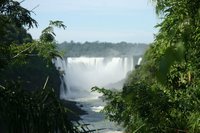


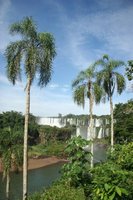
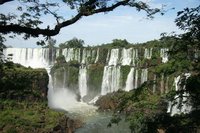
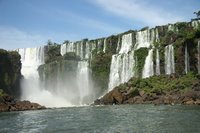

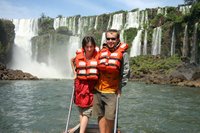
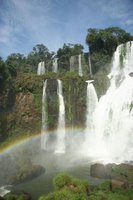
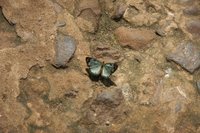







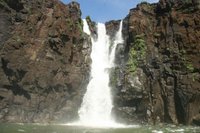





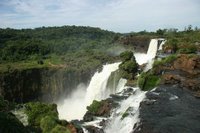

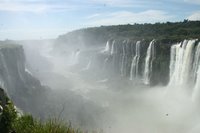
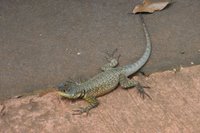




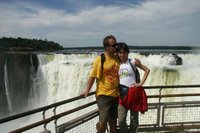
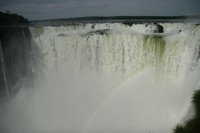







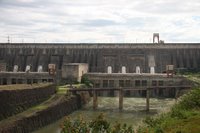

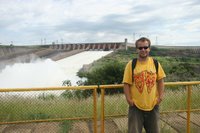
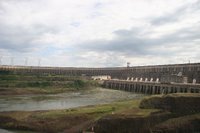
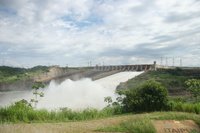
Reszte parku zwiedzamy na piechote, co zajmuje nam reszte dnia. Nastepnego dnia chcemy jeszcze tylko zwiedzic ogromna zapore Itaipu na terenie Brazylii i ruszamy w strone boskiego Buenos!
Wstajemy rano i ruszamy do zapory. Na granicy brazylisko-argentynskiej jak zwykle odprawa tylko u Argentynczykow (Brazylia nie wstawia pieczatek, jesli wyjezdzasz na 1 lub 2 dni). Nowa oznaka cywilizacji Argentyny bylo to, ze granice przekracza sie tu jak w Europie (poza strefa Schengen), czyli pieczatka do paszportu i czesc. Brazylijczycy trzymaja sie lokalnych zwyczajow, czyli przy wjezdzie trzeba wypelnic formularz, w ktorym pytaja nawet o zawod, nie mowiac o stanie cywilnym, a nastepnie zdac ten formularz przy wyjezdzie. Jesli go zgubisz, placisz 250 zl kary. Chore, ale stosowane prawie na calym kontynencie. Jak mowilem, mozna opuscic ten kraj nie stemplujac paszportu, ale z kolejnym wjazdem w innym miejscu lub o innym czasie moga byc problemy (np. jest pieczatka wjazdowa a brak wyjazdowej). W Argentynie natomiast trzeba przechodzic przez specjalna wycieraczke nasaczona jakims srodkiem dezynfekujacym. Ciekawe, ale niezbyt klopotliwe.
Asia jest w pochmurnym nastroju, bo dwa dni wczesniej w Brazylii kupila sobie koszulke z napisem “Jestem Brazylijka” a ja gdziej jej te koszulke zapodzialem. Kiedy na miejscu w sklepie przed wycieczka do tamy okazuje sie, ze to byl jedyny egzemplarz, jest na mnie naprawde zla. Tlumaczenia, ze w napis na koszulce nikt w Polsce nie uwierzy, (nawet gdyby go zrozumial), a w Brazylii tym bardziej tylko pogarszaja sprawe. Z nosami na kwinte lapiemy autobus do tamy.
Na miejscu ogladamy propagandowy filmik brazylijsko-paragwajskiego przedsiebiorstwa Itaipú Binacional, o tym jakie to wspaniale dzielo hydrotechniki. Rozmiary i dane sa imponujace: rzeka Paraná generuje w tej elektrowni 25% pradu zuzywanego przez Brazylie (ten kraj ma 200 mln ludzi!!!) i 90% energii w Paragwaju. Olbrzymi rezerwuar stworzony tam sztucznie na rzece podobno spowodowal jakies szkody w srodowisku naturalnym (zatopienie wodospadow Sete Quedas, wiekszych niz Iguazu itp.), ale o takich drobiazgach film nie wspomina. Potem zabieraja nas w wygodnych klimatyzowanych autobusach na wycieczke, razem z grupa starszych Japonczykow i Amerykanow. Wszystko za darmo – imponujace dzielo propagandy! Sama tama nie zwala z nog swoim pieknem, ale jej rozmiary nie pozostawia nikogo obojetnym. Nie widziemy zbyt wiele, a wycieczka jest krotka, ale informacje takie jak to, ze z metalu zuzytego do budowy mozna zrobic 320 wiez Eiffla, a z betonu 25 stadionow Maracaná (stadion w Rio) przemawiaja do naszej wyobrazni. Ok, woda huczy nam w glowie od trzech dni, czas wycofac sie na suchsze tereny. Ruszamy do jezuickich misji San Ignacio. Poniewaz tym razem musimy wysiasc aby dostac pieczatke wyjazdowa po stronie brazylijskiej, bo juz tu nie wracamy, autobus odjezdza. Nastepny za pol godziny, wiec aby zdazyc do San Ignacio na 19.00 (podobno ma byc spektakl swiatlo i dzwiek!!!) musimy wziac rozklekotana paragwajska taksowke do terminalu po stronie argentynskiej. Jade w bagazniku, kasuja nas slono, ale szczesliwi zdazamy na autobus. Pierwsze wrazenia z jazdy argentynska komunikacja dalekobiezna sa doskonale.Autobus jest wygodny jak malo ktory w Brazylii (nie mowiac o innych krajach), pietrowy, kosztuje smiesznie malo w porownaniu do Brazylii i dojezdza na czas!!! Zdyszani z ciezkimi plecakami dobiegamy do misji, po czym okazuje sie, ze spektakli juz dawno nie ma. Cholerny przewodnik… Meldujemy sie u uroczej starszej pani w pensjonacie i ruszamy na podboj lokalnych stekow. Wolowina w malej familijnej restauracyjce nie jest zla, choc ciut twardawa, ale doskonale wino za 9 zl za butelke przemawia do mnie mocniej niz cokolwiek innego! Zdaje sie, ze wyrobie tu swoja roczna norme picia wina w miesiac. Tak trzymac!
Next day we´re off to visit the falls from close up on the Argentinian side. Within the park tourists are transported by a cute electric train rather than by a bus and the park itself is much bigger. We get to buy a boat ride under small falls at a very decemt price. When our “captain” takes us under a cascade (there are tens of them there) I feel like screaming! It´s sensational especially when for a moment we´re smitten by flushing water. Seems like we´re about to sink. The camera is safely stashed in a plastic bag but I get soaking wet, nevermind the goretex jacket i´m wearing (the water got in from the above, huh). This is the best spent money since the beginning of our trip!
We visit the rest of the park walking, which takes us the rest of the day. Fot the next day we´re only left with the giant Itaipu dam in Brazil and then we´re off to see the divine Buenos! We get up early in the morning and head for the dam. On the Brazilian-Argentinian border there is a border control only at the Argentinian side (the Brazilians don´t insist on giving you stamps if you only leave for 1-2 days). Another symptom of Argentina´s higher civilization is that you cross the border just like in Europe (outside the Schengen area) – meaning you get a stamp in your passport and you´re all set. The Brazilians stick to the local customs, that is on entering you need to fill out a form where they even ask about your profession, not to mention your marital status, and then you´re required to present this form when leaving the country. If you lose it, you pay over 80 bucks penalty. That´s ridiculous but it´s a generally accepted procedure on this continent. As I said, you can leave the country without getting a stamp, but next time next place you may get into trouble (e.g. you have an entry stamp but no exit stamp). Meanwhile, in Argentina you only need to walk on a special mat soaked with a sanitizing agent against the foot and mouth disease. Curious but not very unpleasant.
Asia is cross with me because two days before she bought a T-shirt saying “Sou Brasileira” (I´m Brazilian) and I managed to lose it straightaway. We get back to the store to learn it was the only specimen and now she´s really mad. I only make things worse when I tell her that nobody in Poland would believe the inscription (even if they got to understand it), to say nothing of the Brazilians. Both blue in the face, we catch a bus headed to the dam. They show us a propaganda clip made by the Paraguayan-Brazilian company Itaipu Binacional about what a great work of hydroengineering it is. The size and statistics are awe-inspiring: the Parana river generates here 25% of electricity used in Brazil (this country has 200 million people!) and 90% of the one used in Paraguay. The giant reservoir artificially created on the river allegedly caused some damage to the environment (flooding the Sete Quedas falls, which were larger than the Iguacu Falls) but the movie fails to mention such minor details. Then they take us in comfortable air-conditioned buses for a ride, with a group of retired Japanese and Americans. All for free – what an impressive propaganda effort! The dam itself doesn´t take your breath away but it´s still a wow! sight. We can´t see much, the trip is quite short but the info such as that the metal used to build the dam would be enough to make 320 Eiffel´s towers and the concrete, to make 25 Maracana (in Rio) stadiums appeal to our imagination. That´s it! The water has been roaring in our heads for three days now, it´s time to move to some drier land. We go to San Ignacio´s Jesuit missions. Because this time we need to get off the bus to get the exit stamp at the Brazilian side, as we´re not coming back, the bus leaves us at the border. The next one comes in half an hour and to get to San Ignacio by 7 pm (supposedly there´s a light an sound show!!!), we need to take a rickety Paraguayan taxi to the terminal at the Argentinian side. The car is full so I ride in the trunk, they charge us a lot, nevertheless, but we´re still happy to catch the bus. First impressions from using the Argentinian long-distance bus service are stunning. The bus is more comfortable than most buses in Brazil (not to mention other countries), has two decks, costs peanuts compared to Brazilian prices and guess what? It even gets on time! With our heavy backpacks on, we reach the mission running on the top of our lungs. Of course there are no shows anymore. Damn you, Lonely Planet. We check in at a hosteria run by a dear old lady and we´re off to hunt some local steaks. The beef at a local comedor is not bad, albeit a tad hard on our teeth, but a 3 dollar botte of excellent wine speaks to us louder than anything. I guess I´ll use my annual wine quota in a month! Good for us!















































0 Comments:
Prześlij komentarz
<< Home